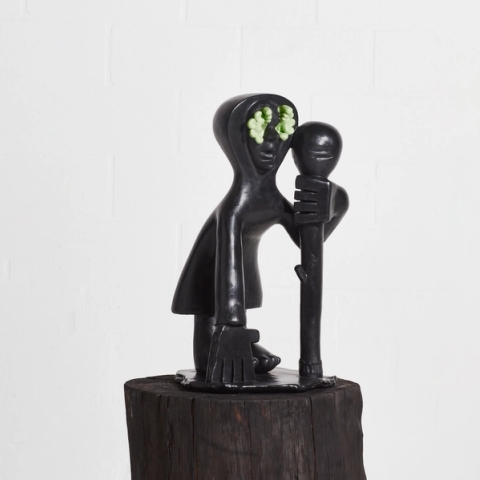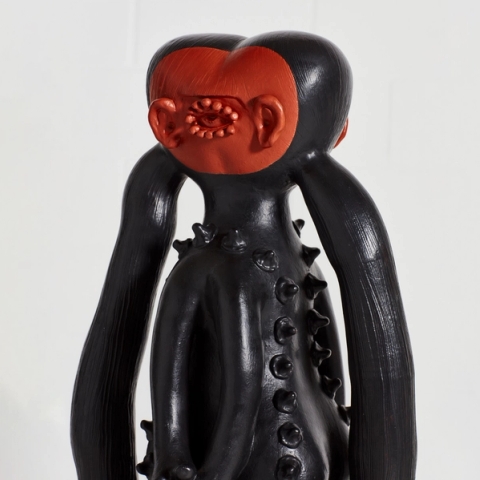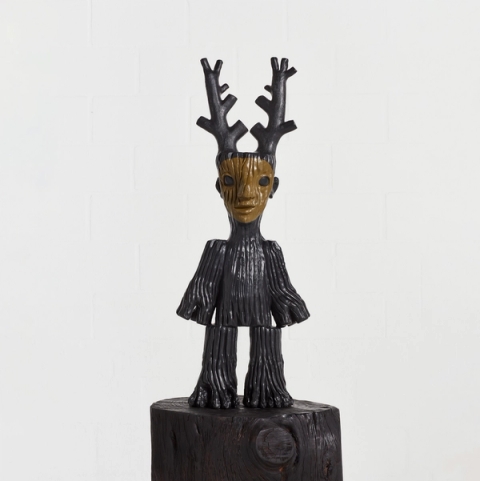My Enquiry (0)
No artwork has been selected.
Please choose an artwork to enquire.
Enquiry Submitted
Thank you for your enquiry and interest in our artists’ work. A member of the gallery team will respond shortly.
000%

Justine Mahoney on the healing power of the mythopoetic imagination
9 Apr 2024 (8 min) read
Through her re-imagining of the Jungian archetypes in her solo exhibition, VIGIL, Justine Mahoney invites viewers to explore the depths of the collective human unconscious. In this Q & A with Lindokuhle Nkosi, she delves into the psychic and creative process that brought forth this new series of ceramic sculptures and enamel paintings.
LN: How do the Jungian archetypes in VIGIL serve as vehicles for expressing facets of the collective human unconscious, particularly in relation to the theme of gender?
JM: With this body of work, most importantly, I wanted to find what is common to all of us in a world so divided – what binds us and what we share as a people. At the onset of the pandemic, it felt like we all went into a kind of internal science fiction: the lines between fantasy and reality were blurred, as if in a dream. During this time, I read Carl Jung’s Red Book, in which he confronts and engages with his unconscious and documents it. This was gold for me; I could now find my way through the madness.
The archetypes live in the unconscious and we can call them up at any time depending on what we are going through, no matter what gender we are. I believe the archetypes themselves are gender fluid and that men can embody the Mother archetype and women can embody the King archetype, for instance. Embracing the masculine and feminine aspects we all have in us can make us so much richer as humanity.


LN: The process of sculpting and painting in VIGIL involved a deep engagement with Jungian meditation and mythopoetic imagination. How did these practices inform your portrayal of feminine archetypes, such as the Mother figure?
JM: The word “vigil” means “a watchfulness for any reason during normal hours of sleep”. With this work, I stood vigil over myself, a watchfulness over my own psyche. I wrote down my dreams, started a meditation practice and made notes after using Jung’s active imagination process – there is word for it, “katabasis”, meaning the descent into the underworld.
There I discovered that the imaginal is real and you can engage with it by going down into the dreamscape – the dark fertile place, the cave, the sea. These places encompass the soul of humanity and are where the great myths live – like Nyx, the embodiment of night; Hades, the king of the underworld; and Hypnos, the personification of sleep.
The feminine lives in all of the archetypes, including the King if he is wise. When I encountered the mother and the Queen archetypes, they told me they are rising like the sap in trees. The mother is reaching upwards, despite her extreme exhaustion from incessant giving. She is related to the pre-religion or pagan vulva-revealing Sheela na gig carved on standing stones throughout Ireland, Britain and Europe.
LN: Your work often embodies a transgressive, hybridised figuration. How does this approach challenge conventional representations of gender, and what role does it play in your exploration of esoteric knowledge systems?
JM: The hybridisation of forms came about from my obsessive need to find what the essence of each archetype portrays. I believe that the archetypes constellated in me as I drew, painted and formed them in clay. I wanted to capture their forms as if they were seen directly in the dream or in the imaginal place. They seemed to be in a state of flux, shapeshifting, running across the inner field, sometimes taking time to tell me something, hiding, glitching out, stopping, fading out, flickering like mirages. They presented themselves in unexpected bodies, with gigantic hands and feet, dinosaur-like. Contorted torsos, some having protruding animal and vegetable shapes, recurring nipples, limbs boiled down to their essences. Appendage-like hair, almost snake-like. Emerging, essences oozing out.
I think our media has tried to show us what femininity is, but it never gets it right. What I am searching for is the strange and the hidden, what lies beneath. There are archetypes in our animal, plant, rock and fungi kingdoms. Humans are part of the animal kingdom. Forms can be seen as emerging from the prima materia, the base of all matter.
LN: The figures in VIGIL are depicted as amorphous vessels, embodying both creation and destruction. Can you elaborate on how these representations reflect themes of agency and power, particularly within the context of Jungian psychology?
JM: In Jungian psychology, there are high notes and low notes, and a sliding scale in-between. If we recognise this, we will know that we all carry atrocity and benevolence within us. We can be diabolical and nurturing, we can hate and love. Knowing this allows us to come to terms with the monstrous, accept it and possibly embrace our shadows so that we do not have to act them out because of our awareness. Does the King know this? When there is a harmonious union between the King and Queen within us we produce the androgynous being and our psyche becomes aware of the unconscious elements within us. The hermaphrodite is born, the opposites live together in balance. We have married the order to the chaos.
LN: The use of the Shou Sugi Ban technique to treat the timber plinths adds a layer of ritualistic symbolism to the presentation of your sculptures. How does this element contribute to the overarching themes present in your artwork?
JM: There are ritual elements present throughout the work. It felt like the act of making all of this work was a ritual, a compulsive daily practice of asking who and what the archetypes are in introspective dialogue. I felt the work needed grounding, and wood is the perfect substance for this, rooting them down. The blackening of the wood was a ritual of fire, called calcination in alchemy. The colour black represents chaos, that which is hidden and buried, the material of the unconscious. Calcination refers to the burning away of parts that no longer serve us, and can also be likened to the dark night of the soul.
LN: In your previous series, Tainted and Mage, you worked extensively with digital collage. How does your experience with digital media inform your approach to sculpting and painting in VIGIL?
JM: I feel that I am drawing from the same unconscious place. When I worked with digital collage, I drew upon a vast library of images I have collected. Perhaps this library has settled into the unconscious where I can work with the forms more directly, first with rough drawings, then between the sculpture and painting. The move away from working with digital images felt like a more immediate way of working – more direct, tactile and visceral.
LN: Your enamel paintings on fabric appear flattened, reducing the sculptural forms to deliberate silhouettes. How does the shift from two to three dimensions influence the viewer's perception of the archetypal figures?
JM: In trying to catch their shapes I made simple, child-like drawings. For me, this is the best way to find a form – to make outlines. I had to fight with the rough texture of the fabric to find the archetypal forms, almost like hieroglyphics or early cave paintings. I wanted to find the universal and non-specific, so that all people can relate to the work. The colours I have used intentionally create a vibrancy, an energetic pulsation of the eye, where there is almost a blur between the colours. Delineating the flattened forms helped me find the sculptural forms, which became totem-like. These totems are not gender-specific.


LN: VIGIL invites viewers to engage with ancient, inner knowing during a time of global upheaval. How do you see your artwork contributing to discussions surrounding gender?
JM: I see this as something we can all engage with. As systems fail us, societies collapse and things fall apart, we have to turn inward. This is the place where we find how to move forward, by asking questions of the imaginal space. Do we turn to the Sage archetype to find courage and guidance? The Mother, the great matriarch? Are we guided by our gut? Do we break taboos like the Trickster?
Have we befriended the Dragon in our shadow parts? Do we meet the Lover for inter-connectedness? Do we break boundaries like the Rebel? Do we become re-enchanted by the Magician? Do we leave the confines of society with the Wanderer? Do we start again and play with the Child? Do we kill the King to bring forth the new conscious King? Do we rise up with the Queen? Do we defend ourselves like the Heroine?
LN: The Wanderer archetype in your sculptures holds the head of a wolf, symbolising the hungry seeker returning from the divine hunt. Could you discuss the significance of this imagery within the broader context of feminist spirituality and empowerment?
JM: Taking one’s self out of the confines of a broken society, I found the incredible story of LaLoba, the Wolf Woman, in Clarissa Pinkola Estés’ book, Women Who Run with the Wolves. She traverses landscapes in search of bones to assemble into wolf shapes in her cave, singing them back to life as they regrow flesh and fur. She runs with them, breathing life back into herself – are-wilding. She is making her own religion, perhaps returning to a pre-colonial and pre-religion time.
LN: As an artist with a three-decade-long career, how has your understanding and portrayal of self, of us as the larger collective, and yourself in the larger collective evolved over time, and what do you hope viewers will take away from experiencing VIGIL?
JM: I feel my work has evolved with each series I have produced. With Innocence, the forms I worked with were brought to their essence as if made by a child. With Tainted, I made crude collages to develop my forms, dealing with growing up in South Africa and bringing together the disparate nature of our culture. With Mage, I used collage again, almost channeling or pre-cognising the dystopian future we were all about to experience(my show opened two weeks before the pandemic hit). With Vigil, I feel I have pushed the reset button: it feels like a new beginning for me, working with my unconscious to bring up archetypal forms common to all cultures. I feel that if we can find commonalities rather than separation, we have a way forward; through the imaginal, we can imagine ourselves into being.


